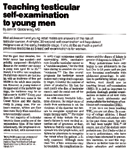Should we teach testicular self-exam?
The eighth in a year-long series of commentary reviewing topics published in Contemporary Pediatrics 25 years ago. This month's review reexamines the evidence for teaching testicular self-exams to young men.

In many ways, this article was a landmark. First, it was one of the few articles in the burgeoning specialty of adolescent medicine to focus on young men. Second, it suggested an approach that would help pediatricians engage the male adolescent; guidance that was much needed at the time it was published. Finally, it offered the promise of early detection, just as breast self-examination (BSE) held out the hope that women would detect cancerous lesions at an earlier, more curable stage.
Why then, does the United States Preventive Services Task Force (USPSTF) recommend against teaching TSE, stating that the "harms of screening exceed any potential benefits"?3 There are several reasons. First, advances in treatment of testicular cancer (ie, chemotherapy) have significantly improved survival and cure rates for this malignancy, with five-year survival rates exceeding 96% even in the absence of a screening program.4 Currently, there are only 380 deaths per year from testicular cancer in the US.4 With these survival rates in the absence of a screening program, it becomes much more difficult to demonstrate the benefits of screening, unless the incremental benefits are truly dramatic.

The conventional wisdom in 1985 was that teaching TSE was not associated with any "costs." But because testicular cancer is relatively rare-especially in comparison to other palpable lesions in the scrotum (spermatocele, varicocele, hydrocele, head of the epididymis, appendix testis)-adolescents who perform TSE may wind up with bills for physician visits, urinalyses, and/or radiologic procedures (eg, a scrotal ultrasound) to evaluate a benign lesion.
Besides these medical costs, it is difficult to estimate the cost of the anxiety an adolescent might experience until the scrotal lesion he finds during TSE is fully evaluated and determined to be benign. Since physician time with each patient is limited, there are also "opportunity costs" associated with TSE: time spent teaching TSE is time that is not available to counsel about seat belt use, drinking and driving, bicycle helmet use, or other potentially risky behaviors. However, the USPSTF does acknowledge that there are no studies that address the "harms" or costs associated with testicular cancer screening.
The USPSTF recommends against teaching TSE to young men; it does not recommend that physicians skip the genital exam in their male patients. Goldenring wrote that one of the major causes of delay in diagnosis is the failure by physicians to recognize the tumor when an adolescent male is examined. Older literature suggests that one quarter to one half of young men with testicular cancer evaluated by a physician are first diagnosed as having some other scrotal pathology.2 The easy accessibility of ultrasound and enhanced teaching of adolescent medicine in pediatric residency programs may have altered these numbers. But even so, it is essential that all pediatricians be comfortable performing a genital exam on a young man as part of a routine well-adolescent exam, and be knowledgeable about the various types of scrotal pathology and variants of normal they are more likely to encounter than a testicular mass.
Hence, while Goldenring's 1985 recommendation to teach TSE is not supported by current evidence, the article is still worth reading as a primer on an important aspect of health care for adolescent males.
DR. JOFFE is Director of Johns Hopkins University Student Health & Wellness Center, and is Associate Professor of Pediatrics, Johns Hopkins University School of Medicine, Baltimore. The author has nothing to disclose in regard to affliliations with, or financial interest in, any organization that may have an interest in any part of this article.
REFERENCES
1. Goldenring JM: Teaching testicular self-examination to young men. Contemp Pediatr 1985;2(7):73
2. Elford RW: Screening for testicular cancer. In: Canadian Task Force on the Periodic Health Examination. Canadian Guide to Clinical Preventive Health care. Ottawa: Health Canada, 1994:8942
3. Agency for Healthcare Research and Quality: Screening for testicular cancer, Topic page. US Preventive Services Task Force. Rockville, Md. February, 2004
4. National Cancer Institute: Cancer Statistics: Surveillance Epidemiology and End Results. Available at: http://seer.cancer.gov/statfacts/html/testis.html. Accessed June 22, 2009